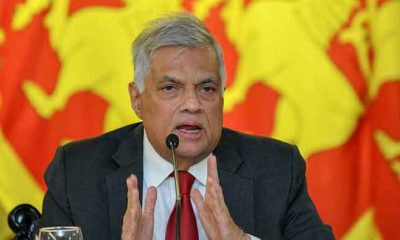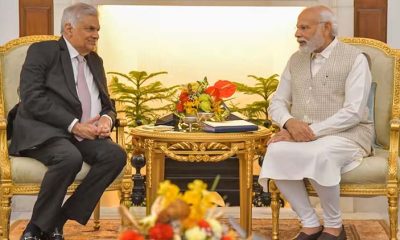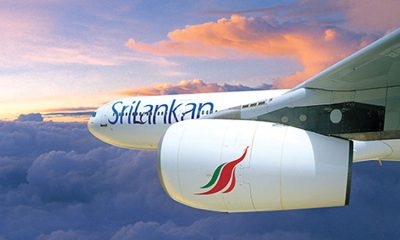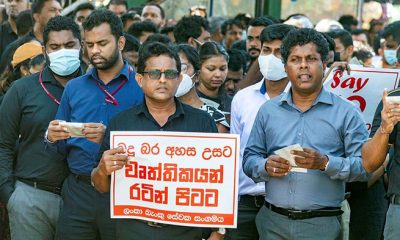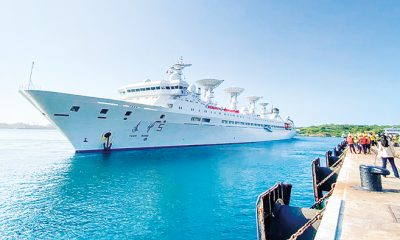Features
A Sri Lankan initiative to meet global challenges
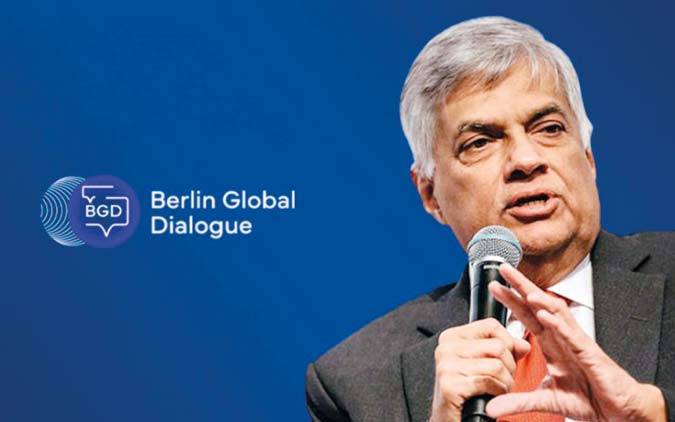
By Neville Ladduwahetty
President Ranil Wickremesinghe eloquently outlined the current global economic crisis affecting the developing world, in particular the Global South, during his speech at the Berlin Global Dialogue. In the course of his presentation he conveyed the fact that while the developed countries may have the strength and resources to weather the challenges, the Global South is not equipped to meet them.
Attributing the current crisis as being due to a combination of systemic inadequacies in the global order and geopolitical rivalries among the major powers, he concluded by stating that if another crisis is to be avoided it is imperative that these powers engage in a constructive dialogue. His plea was that: “We require a constructive dialogue between the West and China. We need a constructive dialogue between the US and China. We need a constructive dialogue between the EU and China. Otherwise we will not move forward. So this is the stark reality. It is a question of how we get together and how we work, and who is going to take the lead in 2024” (Observer, October 1, 2023).
CURRENT GLOBAL LANDSCAPE
With regard to the global landscape he stated: “The Global economy has had many shocks in the past two decades. Starting from 2008, we went through the European debt crisis, then the Covid pandemic, the economic shocks that have come from it, the whole issue of funding for Climate Change, and the Sovereign Debt crisis”.
“In all these instances, it is the developing economies and the Global South that have suffered extremely. We are now faced with stubbornly high inflation in advanced countries, oil prices edging towards US$ 100 a barrel, and monetary tightening by global Central Banks”.
“One example is that Sri Lanka’s exports to Europe have not increased at all this year. That is an indication of how we are being affected as we try to recover from the crisis we face. The confluence of factors face serious risks for many developing countries. In the Global South, we are facing rising import costs, food, energy insecurity and the problem of our exports. The resulting Balance of Payment stress translates into a weaker economy for all of us”.
“The difference between the advanced economies and the developing nations is that you all have the buffers and reserves to deal with these chocks. We do not. It is from here that the sovereign debt crisis started” (Ibid).
SYSTEMIC INADDEQUACY to ADDRESS CURRENT CHALLENGES
Commenting on the existing financial architecture the President stated: “The many crises and shocks we have discussed today are interlinked. First, we all agree that the core of the international financial architecture today was designed almost 80 years ago. The world has seen dramatic changes since then with many emerging economies in Asia, Middle East, South America and Africa becoming global economic powerhouses…. The international financial architecture available makes the debt restructuring too complex…. The IMF has no mechanism to face this new situation…” (Ibid).
OPTIONS for DEVELOPING COUNTRIES
In the context of the global situation cited above, what options are open to the developing countries. Can they afford to wait until the existing financial architecture and institutional reforms are implemented in time to meet the impending challenges knowing that such reforms would be spearheaded by the developed countries to further their interests as it is with the existing financial architecture. Since the developed countries would be preoccupied with their own priorities, it is unlikely that the needed reforms would be developed in time to make a difference globally.
Under the circumstances since the developing countries cannot wait until the development of the needed reforms, the challenges are bound to overpower the developing countries which in turn would affect the developed world as well. Therefore, the only option for the developing countries is either to act collectively or individually, to develop the architecture needed to meet the challenges.
Since it is unlikely that the developing countries would engage in a dialogue to develop a collective framework that would enable them to survive the rigors of a potential crisis in time, it is most likely that each of the developing countries would opt to make their individual hard choice. Consequently, the choices made by some of the developing countries would be for non-alignment or hedge their fate with each of the major powers while others would opt to bandwagon, or connect with one of the major powers and become a vassal state. These policies would change with the political formations in the developing states; a tendency that would be induced by the major powers hoping to extend their spheres of influence.
As for Sri Lanka, its stated policy is to be Neutral in order to cope with the pressures arising from the rivalries among the major powers due to Sri Lanka’s strategic location in the Indian Ocean, while maintaining friendly relations with all States in respect of commercial and cultural endeavours.
OPTIONS FOR SRI LANKA
Since no country has been spared the impact of the global economic crisis, some more than others, Sri Lanka has to seriously revisit some of the policies it has been pursuing to revive its economy. One of the key policies to revive the economy is to focus on an export driven economy. In a background where Sri Lanka’s imports exceed exports, and it is hoping to relax import restrictions even further, such a policy depends on the success of not only adding value to imports but also finding markets for the exports. In view of the shrinking global markets such a policy could turn out to be a costly undertaking.
Another stark reality is that Internal expenditure exceeds Revenue. In such a background how realistically possible is it to attract Foreign Direct Investments or Investors? In order to address this deficit, it is reported that the Government hopes to lift the ban on imports in order to increase revenue concerns of the IMF (The Morning, October 3, 2023). Implementing such a policy would mean a drain on Dollar reserves to raise Rupee revenue and in the process tempt further corruption; a charge already associated with Imports. Exploring such options in the current context is unthinkable unless the imports are only for value addition.
On the other hand, and considering the global situation it would be more prudent to focus not on exports, but instead on reducing imports. For instance, exports from India to Sri Lanka in 2022 were around $4.5 Billion whereas exports from Sri Lanka to India was only $850 Million. If the imports from India were to decrease, it is imperative that Sri Lanka focuses on reducing imports which translates into developing Internal Strengths
SELF-RELIANCE as the MEANS to DEVELOP INTERNAL STRENGTHS
Self-Reliance is a civilizational core value of Sri Lanka. The essence of self-reliance is to develop internal strengths through which the dignity of an independent Nation State is restored. Therefore, as a nation all citizens of the Sri Lankan Nation should pledge to respect and honour the dignity, heritage and identity of all Sri Lankans in order to create a stable and peaceful society as a united endeavor. In addition, the three major communities should engage in a comprehensive dialogue committed to explore arrangements that offer greater dignity and respect for all in preference to current arrangements. Such an arrangement would be for all three communities to share power at the Center and participate in governance processes with the Districts under District Development Committee made up of Public Servants, Chairmen of Local Governments and Members of Parliament in the District becoming the peripheral instruments to implement Government policies.
SUGGESTED FIELDS TO BUILD INNER STRENGTH:
The focus of Agriculture and Irrigation should be to produce all agricultural, horticultural, dairy and poultry products including inputs needed to sustain food security within Sri Lanka, and for export. While high yield varieties of paddy together with inorganic fertilizer for reasons of compatibility are needed for food security, indigenous varieties of paddy using organic fertilizer should be cultivated and marketed as health products for local consumption and exported at premium prices to compensate the cultivator for the lower yields. Irrigation Department to restore ancient tanks in preparation of the consequences of Climate Change.
Instead of divesting Small and Medium Enterprises (SMEs), their ownership should remain with the State while Management is offered to the Private Sector with selection being based on the effectiveness of the proposals submitted.
The performance of each SME should be reviewed regularly by the relevant Parliamentary Oversight Committee. Local investors to be provided with incentives for investment in renewable energy. The Government should take steps to double the generation capacity of Victoria Hydro Power Facility. Review the rationale of the logic to transfer water from Randenigala to the North via the Upper Elahera Canal at an enormous cost and implement alternatives suggested in previous articles. Allocate unused land acquired by the Land Reform Commission to restore lost ground cover in order to increase precipitation and control runoff to minimize flooding and landslides.
All Acts of Parliament relating to fishing, exploration and exploitation of marine resources in the Exclusive Economic Zone should be updated to include provisions of the UN Convention of the Law of the Sea in other to maximize benefits from these resources and impose penalties for illegal activities such as bottom trawling in the Exclusive Economic Zone.
Regulation of mines and mineral development to be under the Direct Control and Operation of the Government with the guidance of the Geological Survey and Mines Bureau using resident labour of the area to ensure maximum value addition prior to export. Call for Expressions of Interest to add value to the mineral sands that are being exported.
All projects that could be executed with the capabilities and resources within Sri Lanka to be implemented with locally raised funds arranged by the Developer with the Local Banks and underwritten by the State. Projects that are beyond the technological capabilities of Sri Lanka to be implemented on the basis of Expressions of Interest called for by Sri Lanka on the basis of Domestic Policy priorities.
Encourage and facilitate the development of Indigenous Crafts and Cottage Industries. Government to promote community based cultural activities as part of fostering a common Sri Lankan heritage.
CONCLUSION
In light of the global landscape presented by President Ramil Wichremesinghe at the Berlin Global Dialogue, where the developed countries have the reserves and the resources to meet forthcoming challenges while the developing countries do not, it is imperative that most developing countries explore and prepare themselves how best to face the challenges and survive. What is presented herein is an opinion as to how Sri Lanka could adapt itself to meet the challenges bearing in mind that what is needed is not reform and revitalization of existing outdated formulations and structures that have made Sri Lanka vulnerable to shocks, but a paradigm shift, in thinking because the prevailing political and economic global landscape has no known historical parallel.
For instance, all in Sri Lanka are focused on devolution in the form of the 13th Amendment in full or in a diluted form because of the insistence of India. Consequently, the reaction from most would be to reject any other option. Despite such a response, what is proposed herein instead, is to share powers of governance among the three major communities at the Center. Therefore, the decision that has to be made in particular by the Tamil community is whether their aspiration for “dignity and respect” as referred to by Prime Minister Modi, would be fulfilled by managing one of the nine provinces in an agreed form whether to be associated meaningfully in the governing processes of the whole of Sri Lanka.
When making that choice it should not be forgotten that divesting Central power to the periphery often results in disparities within peripheries and among peripheries as has happened in India and the USA. So long as the choice is made by the Tamil Community in Sri Lanka, it should not matter to India because the Tamil Nadu State would accept the choice made by their kin in Sri Lanka. Since no attempt has thus far been made to explore such an option, President Wickremasinghe should invite the political leadership of both Tamil and Muslim Communities and have a comprehensive dialogue as to how Power Sharing at the Center could be arranged in a form that would be acceptable to all in preference to the 13th Amendment.
These proposals to revive the economy are based on Self-Reliance as the means to develop internal strengths. The most recent living example of developing internal strengths is the building of the East Container Terminal. This project was to be implemented jointly by Japan and a Local Agent. The strong protests by the Unions forced the Government to reverse its decision and award it to be constructed by Sri Lanka Port Authority. The initial phase of this project would be commissioned in 2024. This reflects what can be achieved by having confidence in the abilities of Sri Lanka’s own Peoples backed by the power of the core civilizational value of self-reliance to develop internal strengths. This approach should be initiated to meet current and future global challenges.
Neville Ladduwahetty
October 4, 2023.
Features
The heart-friendly health minister

by Dr Gotabhya Ranasinghe
Senior Consultant Cardiologist
National Hospital Sri Lanka
When we sought a meeting with Hon Dr. Ramesh Pathirana, Minister of Health, he graciously cleared his busy schedule to accommodate us. Renowned for his attentive listening and deep understanding, Minister Pathirana is dedicated to advancing the health sector. His openness and transparency exemplify the qualities of an exemplary politician and minister.
Dr. Palitha Mahipala, the current Health Secretary, demonstrates both commendable enthusiasm and unwavering support. This combination of attributes makes him a highly compatible colleague for the esteemed Minister of Health.
Our discussion centered on a project that has been in the works for the past 30 years, one that no other minister had managed to advance.
Minister Pathirana, however, recognized the project’s significance and its potential to revolutionize care for heart patients.
The project involves the construction of a state-of-the-art facility at the premises of the National Hospital Colombo. The project’s location within the premises of the National Hospital underscores its importance and relevance to the healthcare infrastructure of the nation.
This facility will include a cardiology building and a tertiary care center, equipped with the latest technology to handle and treat all types of heart-related conditions and surgeries.
Securing funding was a major milestone for this initiative. Minister Pathirana successfully obtained approval for a $40 billion loan from the Asian Development Bank. With the funding in place, the foundation stone is scheduled to be laid in September this year, and construction will begin in January 2025.
This project guarantees a consistent and uninterrupted supply of stents and related medications for heart patients. As a result, patients will have timely access to essential medical supplies during their treatment and recovery. By securing these critical resources, the project aims to enhance patient outcomes, minimize treatment delays, and maintain the highest standards of cardiac care.
Upon its fruition, this monumental building will serve as a beacon of hope and healing, symbolizing the unwavering dedication to improving patient outcomes and fostering a healthier society.We anticipate a future marked by significant progress and positive outcomes in Sri Lanka’s cardiovascular treatment landscape within the foreseeable timeframe.
Features
A LOVING TRIBUTE TO JESUIT FR. ALOYSIUS PIERIS ON HIS 90th BIRTHDAY

by Fr. Emmanuel Fernando, OMI
Jesuit Fr. Aloysius Pieris (affectionately called Fr. Aloy) celebrated his 90th birthday on April 9, 2024 and I, as the editor of our Oblate Journal, THE MISSIONARY OBLATE had gone to press by that time. Immediately I decided to publish an article, appreciating the untiring selfless services he continues to offer for inter-Faith dialogue, the renewal of the Catholic Church, his concern for the poor and the suffering Sri Lankan masses and to me, the present writer.
It was in 1988, when I was appointed Director of the Oblate Scholastics at Ampitiya by the then Oblate Provincial Fr. Anselm Silva, that I came to know Fr. Aloy more closely. Knowing well his expertise in matters spiritual, theological, Indological and pastoral, and with the collaborative spirit of my companion-formators, our Oblate Scholastics were sent to Tulana, the Research and Encounter Centre, Kelaniya, of which he is the Founder-Director, for ‘exposure-programmes’ on matters spiritual, biblical, theological and pastoral. Some of these dimensions according to my view and that of my companion-formators, were not available at the National Seminary, Ampitiya.
Ever since that time, our Oblate formators/ accompaniers at the Oblate Scholasticate, Ampitiya , have continued to send our Oblate Scholastics to Tulana Centre for deepening their insights and convictions regarding matters needed to serve the people in today’s context. Fr. Aloy also had tried very enthusiastically with the Oblate team headed by Frs. Oswald Firth and Clement Waidyasekara to begin a Theologate, directed by the Religious Congregations in Sri Lanka, for the contextual formation/ accompaniment of their members. It should very well be a desired goal of the Leaders / Provincials of the Religious Congregations.
Besides being a formator/accompanier at the Oblate Scholasticate, I was entrusted also with the task of editing and publishing our Oblate journal, ‘The Missionary Oblate’. To maintain the quality of the journal I continue to depend on Fr. Aloy for his thought-provoking and stimulating articles on Biblical Spirituality, Biblical Theology and Ecclesiology. I am very grateful to him for his generous assistance. Of late, his writings on renewal of the Church, initiated by Pope St. John XX111 and continued by Pope Francis through the Synodal path, published in our Oblate journal, enable our readers to focus their attention also on the needed renewal in the Catholic Church in Sri Lanka. Fr. Aloy appreciated very much the Synodal path adopted by the Jesuit Pope Francis for the renewal of the Church, rooted very much on prayerful discernment. In my Religious and presbyteral life, Fr.Aloy continues to be my spiritual animator / guide and ongoing formator / acccompanier.
Fr. Aloysius Pieris, BA Hons (Lond), LPh (SHC, India), STL (PFT, Naples), PhD (SLU/VC), ThD (Tilburg), D.Ltt (KU), has been one of the eminent Asian theologians well recognized internationally and one who has lectured and held visiting chairs in many universities both in the West and in the East. Many members of Religious Congregations from Asian countries have benefited from his lectures and guidance in the East Asian Pastoral Institute (EAPI) in Manila, Philippines. He had been a Theologian consulted by the Federation of Asian Bishops’ Conferences for many years. During his professorship at the Gregorian University in Rome, he was called to be a member of a special group of advisers on other religions consulted by Pope Paul VI.
Fr. Aloy is the author of more than 30 books and well over 500 Research Papers. Some of his books and articles have been translated and published in several countries. Among those books, one can find the following: 1) The Genesis of an Asian Theology of Liberation (An Autobiographical Excursus on the Art of Theologising in Asia, 2) An Asian Theology of Liberation, 3) Providential Timeliness of Vatican 11 (a long-overdue halt to a scandalous millennium, 4) Give Vatican 11 a chance, 5) Leadership in the Church, 6) Relishing our faith in working for justice (Themes for study and discussion), 7) A Message meant mainly, not exclusively for Jesuits (Background information necessary for helping Francis renew the Church), 8) Lent in Lanka (Reflections and Resolutions, 9) Love meets wisdom (A Christian Experience of Buddhism, 10) Fire and Water 11) God’s Reign for God’s poor, 12) Our Unhiddden Agenda (How we Jesuits work, pray and form our men). He is also the Editor of two journals, Vagdevi, Journal of Religious Reflection and Dialogue, New Series.
Fr. Aloy has a BA in Pali and Sanskrit from the University of London and a Ph.D in Buddhist Philosophy from the University of Sri Lankan, Vidyodaya Campus. On Nov. 23, 2019, he was awarded the prestigious honorary Doctorate of Literature (D.Litt) by the Chancellor of the University of Kelaniya, the Most Venerable Welamitiyawe Dharmakirthi Sri Kusala Dhamma Thera.
Fr. Aloy continues to be a promoter of Gospel values and virtues. Justice as a constitutive dimension of love and social concern for the downtrodden masses are very much noted in his life and work. He had very much appreciated the commitment of the late Fr. Joseph (Joe) Fernando, the National Director of the Social and Economic Centre (SEDEC) for the poor.
In Sri Lanka, a few religious Congregations – the Good Shepherd Sisters, the Christian Brothers, the Marist Brothers and the Oblates – have invited him to animate their members especially during their Provincial Congresses, Chapters and International Conferences. The mainline Christian Churches also have sought his advice and followed his seminars. I, for one, regret very much, that the Sri Lankan authorities of the Catholic Church –today’s Hierarchy—- have not sought Fr.
Aloy’s expertise for the renewal of the Catholic Church in Sri Lanka and thus have not benefited from the immense store of wisdom and insight that he can offer to our local Church while the Sri Lankan bishops who governed the Catholic church in the immediate aftermath of the Second Vatican Council (Edmund Fernando OMI, Anthony de Saram, Leo Nanayakkara OSB, Frank Marcus Fernando, Paul Perera,) visited him and consulted him on many matters. Among the Tamil Bishops, Bishop Rayappu Joseph was keeping close contact with him and Bishop J. Deogupillai hosted him and his team visiting him after the horrible Black July massacre of Tamils.
Features
A fairy tale, success or debacle

Sri Lanka-Singapore Free Trade Agreement
By Gomi Senadhira
senadhiragomi@gmail.com
“You might tell fairy tales, but the progress of a country cannot be achieved through such narratives. A country cannot be developed by making false promises. The country moved backward because of the electoral promises made by political parties throughout time. We have witnessed that the ultimate result of this is the country becoming bankrupt. Unfortunately, many segments of the population have not come to realize this yet.” – President Ranil Wickremesinghe, 2024 Budget speech
Any Sri Lankan would agree with the above words of President Wickremesinghe on the false promises our politicians and officials make and the fairy tales they narrate which bankrupted this country. So, to understand this, let’s look at one such fairy tale with lots of false promises; Ranil Wickremesinghe’s greatest achievement in the area of international trade and investment promotion during the Yahapalana period, Sri Lanka-Singapore Free Trade Agreement (SLSFTA).
It is appropriate and timely to do it now as Finance Minister Wickremesinghe has just presented to parliament a bill on the National Policy on Economic Transformation which includes the establishment of an Office for International Trade and the Sri Lanka Institute of Economics and International Trade.
Was SLSFTA a “Cleverly negotiated Free Trade Agreement” as stated by the (former) Minister of Development Strategies and International Trade Malik Samarawickrama during the Parliamentary Debate on the SLSFTA in July 2018, or a colossal blunder covered up with lies, false promises, and fairy tales? After SLSFTA was signed there were a number of fairy tales published on this agreement by the Ministry of Development Strategies and International, Institute of Policy Studies, and others.
However, for this article, I would like to limit my comments to the speech by Minister Samarawickrama during the Parliamentary Debate, and the two most important areas in the agreement which were covered up with lies, fairy tales, and false promises, namely: revenue loss for Sri Lanka and Investment from Singapore. On the other important area, “Waste products dumping” I do not want to comment here as I have written extensively on the issue.
1. The revenue loss
During the Parliamentary Debate in July 2018, Minister Samarawickrama stated “…. let me reiterate that this FTA with Singapore has been very cleverly negotiated by us…. The liberalisation programme under this FTA has been carefully designed to have the least impact on domestic industry and revenue collection. We have included all revenue sensitive items in the negative list of items which will not be subject to removal of tariff. Therefore, 97.8% revenue from Customs duty is protected. Our tariff liberalisation will take place over a period of 12-15 years! In fact, the revenue earned through tariffs on goods imported from Singapore last year was Rs. 35 billion.
The revenue loss for over the next 15 years due to the FTA is only Rs. 733 million– which when annualised, on average, is just Rs. 51 million. That is just 0.14% per year! So anyone who claims the Singapore FTA causes revenue loss to the Government cannot do basic arithmetic! Mr. Speaker, in conclusion, I call on my fellow members of this House – don’t mislead the public with baseless criticism that is not grounded in facts. Don’t look at petty politics and use these issues for your own political survival.”
I was surprised to read the minister’s speech because an article published in January 2018 in “The Straits Times“, based on information released by the Singaporean Negotiators stated, “…. With the FTA, tariff savings for Singapore exports are estimated to hit $10 million annually“.
As the annual tariff savings (that is the revenue loss for Sri Lanka) calculated by the Singaporean Negotiators, Singaporean $ 10 million (Sri Lankan rupees 1,200 million in 2018) was way above the rupees’ 733 million revenue loss for 15 years estimated by the Sri Lankan negotiators, it was clear to any observer that one of the parties to the agreement had not done the basic arithmetic!
Six years later, according to a report published by “The Morning” newspaper, speaking at the Committee on Public Finance (COPF) on 7th May 2024, Mr Samarawickrama’s chief trade negotiator K.J. Weerasinghehad had admitted “…. that forecasted revenue loss for the Government of Sri Lanka through the Singapore FTA is Rs. 450 million in 2023 and Rs. 1.3 billion in 2024.”
If these numbers are correct, as tariff liberalisation under the SLSFTA has just started, we will pass Rs 2 billion very soon. Then, the question is how Sri Lanka’s trade negotiators made such a colossal blunder. Didn’t they do their basic arithmetic? If they didn’t know how to do basic arithmetic they should have at least done their basic readings. For example, the headline of the article published in The Straits Times in January 2018 was “Singapore, Sri Lanka sign FTA, annual savings of $10m expected”.
Anyway, as Sri Lanka’s chief negotiator reiterated at the COPF meeting that “…. since 99% of the tariffs in Singapore have zero rates of duty, Sri Lanka has agreed on 80% tariff liberalisation over a period of 15 years while expecting Singapore investments to address the imbalance in trade,” let’s turn towards investment.
Investment from Singapore
In July 2018, speaking during the Parliamentary Debate on the FTA this is what Minister Malik Samarawickrama stated on investment from Singapore, “Already, thanks to this FTA, in just the past two-and-a-half months since the agreement came into effect we have received a proposal from Singapore for investment amounting to $ 14.8 billion in an oil refinery for export of petroleum products. In addition, we have proposals for a steel manufacturing plant for exports ($ 1 billion investment), flour milling plant ($ 50 million), sugar refinery ($ 200 million). This adds up to more than $ 16.05 billion in the pipeline on these projects alone.
And all of these projects will create thousands of more jobs for our people. In principle approval has already been granted by the BOI and the investors are awaiting the release of land the environmental approvals to commence the project.
I request the Opposition and those with vested interests to change their narrow-minded thinking and join us to develop our country. We must always look at what is best for the whole community, not just the few who may oppose. We owe it to our people to courageously take decisions that will change their lives for the better.”
According to the media report I quoted earlier, speaking at the Committee on Public Finance (COPF) Chief Negotiator Weerasinghe has admitted that Sri Lanka was not happy with overall Singapore investments that have come in the past few years in return for the trade liberalisation under the Singapore-Sri Lanka Free Trade Agreement. He has added that between 2021 and 2023 the total investment from Singapore had been around $162 million!
What happened to those projects worth $16 billion negotiated, thanks to the SLSFTA, in just the two-and-a-half months after the agreement came into effect and approved by the BOI? I do not know about the steel manufacturing plant for exports ($ 1 billion investment), flour milling plant ($ 50 million) and sugar refinery ($ 200 million).
However, story of the multibillion-dollar investment in the Petroleum Refinery unfolded in a manner that would qualify it as the best fairy tale with false promises presented by our politicians and the officials, prior to 2019 elections.
Though many Sri Lankans got to know, through the media which repeatedly highlighted a plethora of issues surrounding the project and the questionable credentials of the Singaporean investor, the construction work on the Mirrijiwela Oil Refinery along with the cement factory began on the24th of March 2019 with a bang and Minister Ranil Wickremesinghe and his ministers along with the foreign and local dignitaries laid the foundation stones.
That was few months before the 2019 Presidential elections. Inaugurating the construction work Prime Minister Ranil Wickremesinghe said the projects will create thousands of job opportunities in the area and surrounding districts.
The oil refinery, which was to be built over 200 acres of land, with the capacity to refine 200,000 barrels of crude oil per day, was to generate US$7 billion of exports and create 1,500 direct and 3,000 indirect jobs. The construction of the refinery was to be completed in 44 months. Four years later, in August 2023 the Cabinet of Ministers approved the proposal presented by President Ranil Wickremesinghe to cancel the agreement with the investors of the refinery as the project has not been implemented! Can they explain to the country how much money was wasted to produce that fairy tale?
It is obvious that the President, ministers, and officials had made huge blunders and had deliberately misled the public and the parliament on the revenue loss and potential investment from SLSFTA with fairy tales and false promises.
As the president himself said, a country cannot be developed by making false promises or with fairy tales and these false promises and fairy tales had bankrupted the country. “Unfortunately, many segments of the population have not come to realize this yet”.
(The writer, a specialist and an activist on trade and development issues . )




